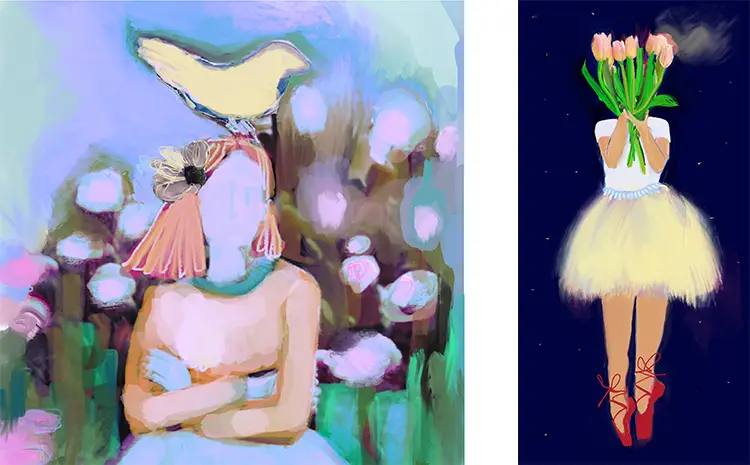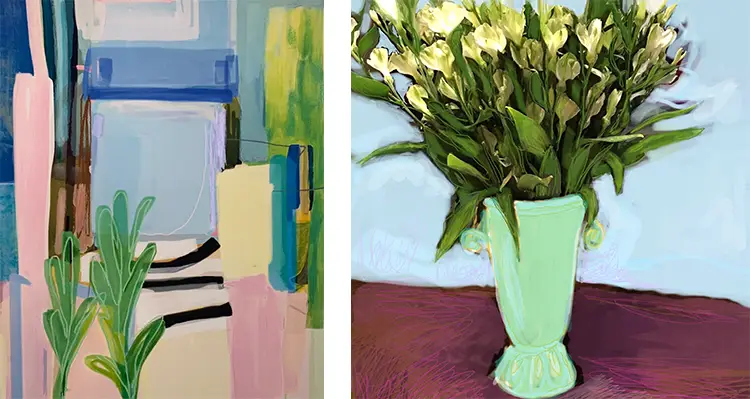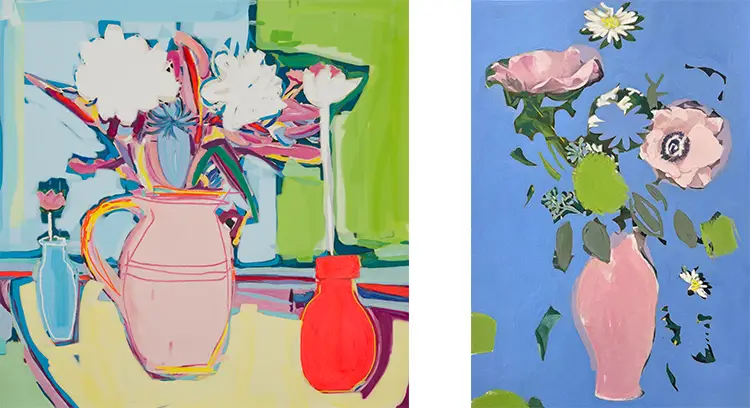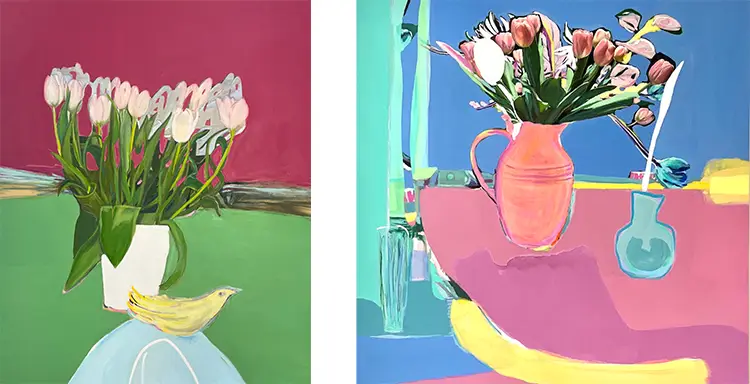“Art doesn’t have to fit into a box—and I didn’t either.”
The Language of Colour, the Memory of Form
Janna Robins Walters has never needed to search for her identity as an artist—it has lived in her since childhood, expressed through every drawing, object arrangement, and vibrant experiment with form and colour. From decorating tuxedo shirts to painting hockey helmets, Janna found early on that creative exploration wasn’t a hobby—it was a core instinct. Her work is not simply an aesthetic endeavor, but a personal language that translates thought and emotion into visual form. Her approach blends tactile interaction with a restless imagination, and her materials—whether digital sketches or physical textures—serve as extensions of her sensibility. Driven by the desire to understand and interpret the world through imagery, she invites viewers to look beyond the visible and into the quietly complex.
This intrinsic creative impulse became evident at an early age. One pivotal moment occurred in third grade when a local art contest awarded her a small savings account for a painting that hung outside a neighborhood bank. That simple validation, modest as it was, helped Janna realize that her creative voice had weight. Encouraged by the support and the recognition, she began to see art not just as a joy, but as a path with tangible meaning. Her academic journey followed naturally, enriched by formal training and summer programs, while her curiosity remained an ever-present guide. Over time, she developed a process that merges digital origins with traditional media, producing layered mixed-media works that mirror her dynamic thought process.
Colour, movement, and nature form the beating heart of Robins Walters’ practice. She’s especially drawn to birds, flowers, and organic shapes that carry emotional resonance. Her visual language is defined by contrasts: the ephemeral with the structured, digital play with physical materials, surface aesthetics with emotional depth. Through this layered process, she highlights the invisible narratives and hidden stories embedded in everyday life. Her art suggests that behind every face and fragment lies a deeper truth—often unspoken, often felt—and challenges the viewer to slow down, observe more carefully, and interpret the unspoken elements within and around them.

Janna Robins Walters: Creating from the Inside Out
At the core of Janna’s creative philosophy lies a belief that everyone carries unseen inner landscapes. It is this sense of hidden depth—the gap between what we show and what we feel—that inspires much of her work. Through abstracted figures, textured environments, and natural motifs, she encourages her audience to explore those interior spaces. Her fascination with fragments—whether of memory, identity, or narrative—leads her to build artworks that feel both familiar and elusive. Janna believes that each person brings their own story to her work, and that personal interpretation is not only inevitable but essential. No two viewers see her work the same way, and she embraces that multiplicity as part of the art itself.
This philosophy extends into her process, which is deeply fluid and adaptive. Janna often begins her pieces digitally, using only her finger on an iPad. This tactile approach—drawing, cutting, and collaging with intuitive gestures—mirrors how her thoughts flow: freely and responsively. Once the initial digital groundwork is laid, she scales the images up and introduces more physical materials—paint, ink, pastel, and other textural elements. Paper and panel become stages for layering and reinterpreting her digital ideas. This push and pull between the digital and the physical allows her to create dynamic compositions that feel at once spontaneous and intentional. She frequently works on multiple pieces at once, allowing one to inform the other while preventing creative stagnation.
The environment in which Robins Walters works is integral to her process. Her studio is a sanctuary where freedom and structure co-exist. She begins her day slowly—grounding herself with rituals like tea, snacks, and audiobooks—before transitioning into a period of uninhibited play. That initial hour, marked by looseness and exploration, opens the door to deeper focus later in the day. Whether guided by ambient soundscapes or immersive mysteries, she lets the work itself determine her pace. Her process is one of intuitive layering and responsive editing, a conversation between mediums and moments, driven by both curiosity and a keen emotional sensitivity.

Textures of Thought, Shapes of Memory
Janna’s attraction to mixed media was never a deliberate choice—it emerged from an evolving relationship with materials that paralleled her shifting creative needs. With roots in illustration and a lifelong habit of mark-making, she began her artistic exploration through traditional techniques like cutting and collaging by hand. The arrival of digital tools like the iPad didn’t replace this foundation; rather, they expanded her toolkit, giving her new ways to translate thoughts into visual form. The fluidity and responsiveness of working digitally reflected how her mind operates—moving quickly, adapting easily, always sketching out new possibilities. These tools allowed her to capture ideas in motion, which she could then return to with paint and texture, refining and reshaping them.
Yet even as her digital process grew more sophisticated, Robins Walters found herself returning to the tactile satisfaction of traditional media. There’s a raw honesty in physical mark-making—a directness that digital work, no matter how advanced, cannot replicate. Paint, pastel, ink, and collage materials enable her to engage fully with the surface, inviting unpredictability and depth into the final work. She doesn’t treat her tools as fixed categories but moves between them instinctively, following the emotional direction of each piece. Her recent interest in returning to more hands-on methods signals a desire to deepen that material relationship even further, potentially moving into three-dimensional space.
One long-held vision involves creating sculptural installations inspired by the natural world. Robins Walters has often imagined building suspended works using leaves, branches, or organic forms—art that would engage not just the eye but the entire body, transforming everyday space into a site of quiet revelation. The work of Andy Goldsworthy, known for his transient, site-specific creations using natural elements, resonates strongly with her. Like Goldsworthy, Janna seeks to explore how materials and environments speak to each other, and how viewers can become physically immersed in meaning. One dream installation—possibly stretched across a bridge in downtown Toronto—embodies this future direction, where spatial and emotional engagement merge in unexpected, transformative ways.

Janna Robins Walters: Embracing the Unseen
For Janna, art has always been about more than what meets the eye—it’s about what lies just beyond it. The surrealism of Salvador Dalí was a turning point in her artistic development, giving her the courage to embrace the strangeness and spontaneity of her own ideas. Early in her journey, she sometimes hesitated to share her more abstract or whimsical pieces, fearing they might be dismissed as too unusual. But Dalí’s bold disregard for convention and his deep dive into subconscious imagery revealed an alternative path: one where eccentricity and emotion weren’t liabilities, but strengths. His unapologetic commitment to his vision made her feel seen—and more importantly, empowered to trust her own.
That realization continues to shape how Robins Walters approaches both her subject matter and her process. She no longer feels bound by expectations or formal categories; instead, she builds a practice that reflects her fluid, sensory, and emotional understanding of the world. This freedom allows her to move between influences—from the sensuality of Matisse and Modigliani to the expressive colour fields of Rothko and Frankenthaler—without losing her own voice. Janna doesn’t replicate her inspirations; she lets them whisper through the layers of her own work, absorbing their essence while maintaining a deeply personal aesthetic. Her art carries echoes of many styles but speaks clearly in her own dialect.
The artists she admires—Goldsworthy, Matthew Wong, David Hockney, Matisse—are united not by technique but by conviction. They trust their inner vision, however unconventional, and use their art to bring unseen ideas into the visible world. Robins Walters follows that same path, crafting works that ask more questions than they answer, inviting viewers to linger in the spaces between clarity and ambiguity. Whether working in colour, texture, or form, she seeks to translate emotional landscapes into visual stories. Each piece is an invitation to look more carefully—to reconsider what we think we know—and to embrace the quiet wonder of what remains hidden.








